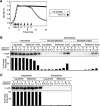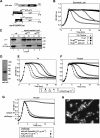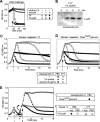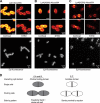LytA, major autolysin of Streptococcus pneumoniae, requires access to nascent peptidoglycan
- PMID: 22334685
- PMCID: PMC3322828
- DOI: 10.1074/jbc.M111.318584
LytA, major autolysin of Streptococcus pneumoniae, requires access to nascent peptidoglycan
Abstract
The pneumococcal autolysin LytA is a virulence factor involved in autolysis as well as in fratricidal- and penicillin-induced lysis. In this study, we used biochemical and molecular biological approaches to elucidate which factors control the cytoplasmic translocation and lytic activation of LytA. We show that LytA is mainly localized intracellularly, as only a small fraction was found attached to the extracellular cell wall. By manipulating the extracellular concentration of LytA, we found that the cells were protected from lysis during exponential growth, but not in the stationary phase, and that a defined threshold concentration of extracellular LytA dictates the onset of autolysis. Stalling growth through nutrient depletion, or the specific arrest of cell wall synthesis, sensitized cells for LytA-mediated lysis. Inhibition of cell wall association via the choline binding domain of an exogenously added enzymatically inactive form of LytA revealed a potential substrate for the amidase domain within the cell wall where the formation of nascent peptidoglycan occurs.
Figures







Similar articles
-
Structural and functional insights into peptidoglycan access for the lytic amidase LytA of Streptococcus pneumoniae.mBio. 2014 Feb 11;5(1):e01120-13. doi: 10.1128/mBio.01120-13. mBio. 2014. PMID: 24520066 Free PMC article.
-
The crystal structure of the major pneumococcal autolysin LytA in complex with a large peptidoglycan fragment reveals the pivotal role of glycans for lytic activity.Mol Microbiol. 2016 Sep;101(6):954-67. doi: 10.1111/mmi.13435. Epub 2016 Jul 5. Mol Microbiol. 2016. PMID: 27273793 Free PMC article.
-
Key role of amino acid residues in the dimerization and catalytic activation of the autolysin LytA, an important virulence factor in Streptococcus pneumoniae.J Biol Chem. 2007 Jun 15;282(24):17729-37. doi: 10.1074/jbc.M611795200. Epub 2007 Apr 16. J Biol Chem. 2007. PMID: 17439951
-
The pneumococcal cell wall degrading enzymes: a modular design to create new lysins?Microb Drug Resist. 1997 Summer;3(2):199-211. doi: 10.1089/mdr.1997.3.199. Microb Drug Resist. 1997. PMID: 9185148 Review.
-
Structure, Function, and Regulation of LytA: The N-Acetylmuramoyl-l-alanine Amidase Driving the "Suicidal Tendencies" of Streptococcus pneumoniae-A Review.Microorganisms. 2025 Apr 5;13(4):827. doi: 10.3390/microorganisms13040827. Microorganisms. 2025. PMID: 40284663 Free PMC article. Review.
Cited by
-
Answer to February 2019 Photo Quiz.J Clin Microbiol. 2019 Jan 30;57(2):e00175-18. doi: 10.1128/JCM.00175-18. Print 2019 Feb. J Clin Microbiol. 2019. PMID: 30700561 Free PMC article. No abstract available.
-
ClyJ Is a Novel Pneumococcal Chimeric Lysin with a Cysteine- and Histidine-Dependent Amidohydrolase/Peptidase Catalytic Domain.Antimicrob Agents Chemother. 2019 Mar 27;63(4):e02043-18. doi: 10.1128/AAC.02043-18. Print 2019 Apr. Antimicrob Agents Chemother. 2019. PMID: 30642930 Free PMC article.
-
Synthesis of bacteriophage lytic proteins against Streptococcus pneumoniae in the chloroplast of Chlamydomonas reinhardtii.Plant Biotechnol J. 2017 Sep;15(9):1130-1140. doi: 10.1111/pbi.12703. Epub 2017 Mar 7. Plant Biotechnol J. 2017. PMID: 28160380 Free PMC article.
-
The Bactericidal Fatty Acid Mimetic 2CCA-1 Selectively Targets Pneumococcal Extracellular Polyunsaturated Fatty Acid Metabolism.mBio. 2020 Dec 15;11(6):e03027-20. doi: 10.1128/mBio.03027-20. mBio. 2020. PMID: 33323510 Free PMC article.
-
Neisseria meningitidis IgA1-specific serine protease exhibits novel cleavage activity against IgG3.Virulence. 2021 Dec;12(1):389-403. doi: 10.1080/21505594.2021.1871822. Virulence. 2021. PMID: 33459578 Free PMC article.
References
-
- Neufeld F. (1900) Über eine specifische bakteriolytische Wirkung der Galle. Z. Hyg. Infektionskr. 34, 454–464
-
- Tomasz A., Albino A., Zanati E. (1970) Multiple antibiotic resistance in a bacterium with suppressed autolytic system. Nature 227, 138–140 - PubMed
Publication types
MeSH terms
Substances
LinkOut - more resources
Full Text Sources
Other Literature Sources
Molecular Biology Databases

